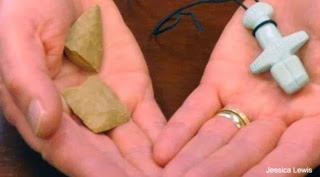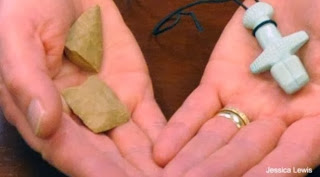Objects found at an archeological site in Cyprus support the theory that the first human colonies in the area appeared about 1.000 years earlier than previously thought. This discovery fills a significant gap in Cypriot history.
Excavations at the Agia Varvara - Asprokremnos Archaeological Site (ABA) by researchers from the University of Toronto, Cornell University and the University of Cyprus have uncovered, among other objects, the oldest complete human figurine on the island.
The archeological site dates between 8800-8600 BC, near the beginning of the Neolithic Period - also known as the Late Stone Age - when the transition from hunting to agricultural holdings gradually spread throughout the Middle East.
"This shows us that Cyprus was an integral part of the Neolithic revolution that saw a significant increase in agriculture and animal husbandry," explains Sally Stewart, a researcher at the Center for Archeology and Anthropology at the University of Toronto. Department of Arts and Sciences of the same University. "With agriculture came the surplus, the abundance of food but also of free time. "People now had time to turn to other activities such as production and the visual arts."
The figurine - a complete female dummy - was found in a collection of fiery stone objects that also included two flat stone tools, one of which bore extensive remnants of ocher. The discovery of the tools provides further evidence of the significant industrial activity associated with the production of stone tools and the processing of ocher.
Until now, researchers believed that Cyprus acquired an agricultural way of life much later than the mainland around the Mediterranean Sea. But with less than 100 kilometers between them, the settlers could easily cross the waters from what is now northern Syria, Turkey and Lebanon, and establish colonies in the area.
"People would have seen the mountains and probably been attracted by the abundance of flint rocks," says Stewart. "They had already started using flint to make stone tools and would like to take advantage of the island's rich resources."
The site was first discovered in the ABA in the early 1990's. Similar sites were found in 1998 by Stewart and Carole McCartney of the University of Cyprus. Preliminary analysis of the objects found there led McCartney to assume that the findings are older than previously thought. By 2005, Stewart, McCartney, and Cornell University archaeologist Stuart Manning had made plans to survey the site at ABA and eventually conducted a complete excavation.
"With these discoveries we can really have a clearer picture of what was happening in Cyprus in the early years," Stewart said. "We can no longer assume that he was on the sidelines in relation to what was happening in the surrounding area at that time."
Photo: Jessica Lewis
Source: SigmaLive

